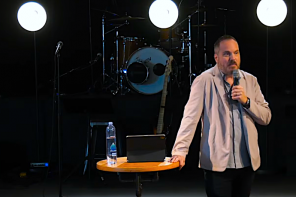“It is easier to imagine the end of the world than the end of capitalism,” critic Fredric Jameson famously mused. This explains why the year 2012 envisioned by Roland Emmerich’s blockbuster, with its gargantuan fireballs and solar cataclysms, seems more plausible than the prophecy put forth by the latest entry in the rush to doomsday, 2012: Time for Change. Rather than mass destruction, it predicts that in two years, we will abandon our smart phones, SUVs, and prescription drugs in favor of hoes, tandem bicycles, and ayahuasca.
At the end of the Mayan calendar, two years from now, the whole world will supposedly start to resemble Burning Man.
Psychedelics, Prophecies, and Counterculture
2012: Time for Change calls itself a “documentary,” which is as fine a category as any for this sprawling, free-associative film. It includes interviews with an assortment of environmentalists, a clip from the O.J. Simpson trial, footage from a free yoga class in Union Square, and bulleted lists about the medicinal uses of hallucinogenic drugs. Filmmaker David Lynch describes how he first started meditating; actress Ellen Page reminisces about the month she spent “shoveling goat shit” at an eco-village following the release of Juno. One of the more interesting interviews in the film is with mycologist Paul Stamets, who discusses how planting fungi can help eliminate toxic waste. You might ask, “What does this have to do with 2012?” You might not get an answer.
While directed by João Amorim, the film appears to be the brainchild of Daniel Pinchbeck, whose narration and on-screen presence ties together the visual miscellany. Pinchbeck, 44, is the paterfamilias of the 2012 cottage industry, having published two books and numerous articles on the topic. He’s a self-described expert on “psychedelics, prophecies, and other countercultural ideas.”
Pinchbeck also appears to be an expert at equivocation. In the introduction to his recent essay collection, Toward 2012: Perspectives on the Next Age, Pinchbeck begins a paragraph by writing, “I do not pretend to know what will happen on that date.” The same paragraph ends, “Some, perhaps many, will not survive.” Fear-mongering and vagueness is a well-worn and pragmatic combination. The former is good for business; the latter will stave off criticisms in 2013.
While the movement’s means might seem a bit dubious to those who don’t otherwise rely on the Mayan calendar, its ends are noble. Pinchbeck and others imagine 2012 as an idyllic time of peace, environmental stewardship, and equality. The film asserts that whatever happens in 2012, it will allow things like rooftop farms, bicycle culture, and other aspects of urban environmentalism to thrive. We will become, the film promises, a culture that takes time for self-reflection and cares for one another. We’ll even live in harmony with animals! It’s Little House on the Prairie meets Woodstock. In sum, it sounds completely lovely. But film does not explain is why we must await the stroke of 2012 to start building this utopian vision.
About a third of the way through, the tone changes from prophetic (“Cable, satellite TV, all of it could get wiped out by 2012”) to instructional. It feels, at times, like a hallucinogen infomercial. Pinchbeck describes the medical benefits of his favorite drugs—for example, he promotes iboga, an African root bark with hallucinogenic properties, as a cure for drug and alcohol addiction. Such theories might be convincing if they came from someone other than Pinchbeck, who borrows haphazardly from Western science when it validates his claims, but seems to distrust it as an all-encompassing worldview. The film’s subtitles proudly announce the PhDs earned by Stamets (who researches plant intelligence) among other biologists. But when the musician Sting goes off about the benefits of taking ayahuasca, scientists are not invited to comment, nor are their opinions welcome when it comes to the Mayan calendar or Pinchbeck’s recommended health regime. He urges his viewers to practice yoga, to meditate, to eat locally, and to appreciate indigenous cultures—in essence, to be a “conscious” bourgeoisie.
The lack of class and global awareness is astounding here. Taking drugs and starting rooftop farms is fun, but it will not uproot corrupt governments, provide a remedy to systemic poverty, or stymie human greed.
The filmmakers crave a socially responsible populace, yet they imagine that no actual responsibility is involved. Instead of spending time and sweat advocating for, say, more bicycle-friendly cities, it would be preferable if the Mayan calendar just made them happen—no effort necessary! Pinchbeck wants the world to be a better place but does not seem to imagine that any of us will have an actual hand in the process.
According to a Rolling Stone profile from 2006, Pinchbeck runs in a crowd of “nubile young things.” That his message appeals to a younger set is not surprising, given the emphasis he places on hallucinogens and Generation Y’s reputation for indifference. I always assumed that apathy in this context is the result of being overwhelmed; we have stacks of college loans to pay back and, compared to our parents, uncertain financial futures. But young 2012-ologists have, it seems, experienced a type of Stockholm syndrome, seeking out a belief system that justifies their disempowerment.
One of the more revealing moments in the film is a discussion of the hippie generation. (It comes shortly after the segment about the oeuvre of Buckminster Fuller.) “I see the sixties as the first phase of a shamanic voyage of initiation of the modern psyche,” Pinchbeck says. “And at this time, we are going through this second shamanic phase of our voyage and now we have elders in place—people who have gone through their initiatory journey who can hold the space for everyone else.” The implication seems to be that young people today lack the initiative of their hippie predecessors who, in any case, have already done much of the work for them.
Meet Me at the Wrecking Ball
Pinchbeck himself was raised among a number of sixties luminaries, including Allen Ginsberg, Abbie Hoffman, and Jack Kerouac. (He lived in Manhattan, where his father was a painter and his mother a Beat writer and editor.) In his twenties, he worked as a freelance journalist and founded a literary journal called Open City. “Once upon a time, not so long ago, I was a typical Manhattan atheist, suspicious, cynical, and disbelieving in metaphysical possibilities,” he writes in the opening of his book Breaking Open the Head. He blames his urbane pragmatism on his parents, whom he describes as “anti-religious” and whose unrealized ideals made him chronically pessimistic. “I watched the wrecking ball of economic determinism destroy the remnants of their liberal, idiosyncratic culture.”
The realities of his chosen profession made him grow despondent and lonely. “I found it extremely difficult to get important information out through the mainstream media. And that’s one reason I started to get more and more depressed,” he explains at the start of the film. His depression led him to try iboga when he went to Gabon on an assignment for Vibe magazine. Shortly after he returned, according to Rolling Stone, one of the co-founders of Open City died of a heroin overdose. Pinchbeck then quit Open City, left journalism, and became more interested in things like shamanism and psychedelics—but he doesn’t go into the details. “I have no personal history,” he has said.
This gap turns out to be the major weakness of 2012: A Time for Change. The documentary floats between irreverent topics—some of which, like Buckminster Fuller and shamanism, deserve films of their own. All the while, it manages to avoid its real subject: the man who was, somehow, enabled to make it. Why, exactly, does Pinchbeck believe “many” people may not survive the transition to utopia and, even more interestingly, why does he seem to wish this to be true?
End-of-the-world predictions have always been motivated by something, whether nihilism, idealism, or power, and there are ethical—and even political—roots of the 2012 movement that don’t appear in this film. A documentary about these would be one worth seeing.




